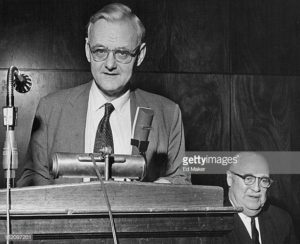Humphry Fortescue Osmond (1917-2004) was an English psychiatrist and researcher who is known for inventing the word psychedelic. His research work centered on finding applications for psychedelic drugs and studying the psychology of social environments like mental institutions.
Osmond received his medical degree from Guy’s Hospital Medical School at King’s College London. During World War II he served in the Royal Navy as a ship’s psychiatrist.
Interest in Psychedelic Drugs
While working at St. George’s Hospital in London after the war, Osmond heard about Albert Hofmann’s discovery of LSDs hallucinogenic properties. He got the idea that schizophrenia might be caused by a chemical imbalance in the brain because it produces symptoms similar to those of LSD and mescaline. He also wondered if hallucinogens could be used to treat mental illnesses. Osmond later wrote, “Schizophrenics are lonely because they cannot let their fellows know what is happening to them and so lose the thread of social support. LSD-25, used as a psychotomimetic, allows us to study these problems of communication from the inside and learn how to devise better methods of helping the sick.” 1
Research Using LSD to Treat Alcoholism
Because there was no interest in developing drugs for use in psychiatry, Osmond relocated to Weyburn Mental Hospital in Saskatchewan, Canada. There he found a hospital with many alcoholic patients who were not responding to treatment. Osmond knew LSD produced symptoms similar to delirium tremens. He set out to dose the alcoholic patients with LSD hoping to scare them into changing their ways. Under carefully controlled conditions, Osmond treated nearly 2,000 alcoholic patients with LSD between 1954 and 1960. He was astonished when the patients had interesting rather than frightening experiences on the drug. Also, 40-45% of those treated had stayed sober a year after their treatment.
The social unrest of the 1960s fueled by the Vietnam War was changing public and political perceptions of drugs like LSD which until that point were still legal. The use of drugs by young people and those in the counterculture was thought to be the underlying problem. Money for studying psychedelics dried up and Osmond, after being on the cutting-edge of the research at the time, was forced to abandon his work.
It’s Now Called the “Mind Show”
When Osmond set out to find a name for the effect LSD has on the mind, he consulted with the celebrated English novelist and his friend at the time, Aldous Huxley. Huxley was interested in psychedelic drugs after first trying mescaline (supplied by Osmond) in 1953. He suggested the name phanerothyme which is taken from the Greek words to show and spirit. Working on his own, Osmond settled on psychedelic from the Greek words for mind or soul (psyche) and show (deloun). He first used the word in a presentation he gave at the New York Academy of Sciences in 1957.2
Filming BBC Reporter on Mescaline
Osmond is well known for giving mescaline to BBC reporter Christopher Mayhew in 1955 and guiding him through the experience as it was filmed. In the video, Mayhew describes the euphoria he feels; an experience he later said lasted for months after. He also experienced an altered sense of time, like he was moving within time itself. The BBC debated whether to air the video, concerned it would encourage people to take drugs. In the end, they deemed the experience ‘not valid’ and never aired it.
More information on Humphry Osmond is found in his 2004 obituary in The Telegraph.

